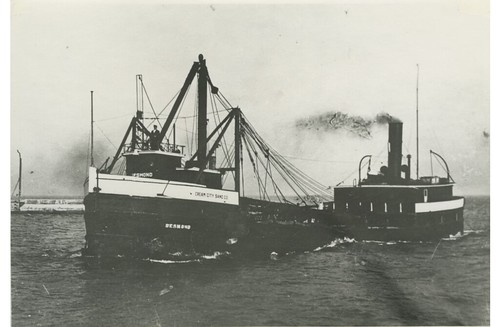Shipwrecks of the Great Lakes: The Desmond
The approximate 6,000 ships that have succumbed to raging storms attest to the power of the Great Lakes. As I traveled, writing and compiling information for my three-volume travel series that explores Michigan's coasts, I heard or read the tales left behind by those ill-fated ships. They add a somber, but compelling backdrop to Michigan’s waterways. This week’s article isn’t about a specific ship. It’s about a place where many doomed vessels disappeared.

Photo: https://greatlakes.bgsu.edu/item/434777
The Desmond, a wooden-hulled propeller, known as a sandsucker or sucker dredge, extracted sand from lake and river bottoms to keep the harbors and rivers open for navigation. The removed sand was then sold for construction and other building purposes.
Owned by the Cream City Sand Company of Milwaukee, the Desmond traveled from harbor to harbor along the Lake Michigan coastline performing her services. December 8, 1917, was her last trip.
December is late in the shipping season, and the Desmond was on her final trip of the year when Captain Emil Thorsen departed St. Joseph that wintery afternoon headed northwest to Racine with his load of sand. Gale winds blew the Desmond off course, hurling her into the path of a nasty squall blowing high waves and subzero temperatures.
Thorsen, a well-seasoned sailor, realized the danger and headed for the safety of the Chicago Harbor. Everyone aboard feared this might be their last trip—not for the year, but of their life. A survivor later described how crew members tried to persuade the captain to run the ship on a beach. He refused. He had been sailing for 30 years and never lost a ship. He declared that if the Desmond went down, she would take him with her.
The continued rocking of the waves shifted the cargo of sand, causing the Desmond to list to starboard. The crew furiously shoveled to level its cargo and get the ship back on an even keel. They were inspired by the lights they saw in the Chicago Harbor. Surely with safety so close, they would be rescued.

Photo: greatlakeships.org/
At 2:00 a.m., the ship developed a leak in the stern. The engines had to be shut down to operate the steam pumps. The crew continued working all that long terrifying night to keep their ship afloat. At the same time, they frantically tried to get someone’s attention to their plight. Water was gaining on them. One of the coal bunkers collapsed. Pieces of coal clogged the pumps and siphons.
The captain decided his only chance to save his ship was to launch a lifeboat and row for help. He desperately needed a tug to haul them in. He and four crewmen boarded the lifeboat and headed in the direction of Chicago. The men had barely gotten the lifeboat moving when the Desmond tipped on its side, and its stack hit and capsized the lifeboat, throwing its occupants into the water.
The men still aboard the Desmond scrambled up top as their vessel tipped. They threw ropes to the five they spotted floundering in the icy water. Captain Thorsen and Frank Kipper managed to grab the ropes and were pulled alongside the ship, but Thorsen froze to death as he lay there. Kipper survived, along with the eight still on board.
The Desmond floated for several hours, buying critical time. The surviving men were rescued by the tug, William A. Field. The Desmond finally sank at 7:00 a.m. Seven men died in the disaster. In retrospect, it is almost certain that with foresight, Captain Thorsen would have willingly run his ship aground. Instead, he lost the first ship of his sailing career. More importantly, he lost his life.

Photo: greatlakeships.org/
Click through to read excerpts from Royce's three books exploring Michigan's coasts:
Julie Albrecht Royce, the Michigan Editor for Wandering Educators recently published a three-book travel series exploring Michigan’s coastlines. Nearly two decades ago, she published two traditional travel books, but found they were quickly outdated. This most recent project focuses on providing travelers with interesting background for the places they plan to visit. Royce has published two novels: Ardent Spirit, historical fiction inspired by the true story of Odawa-French Fur Trader, Magdelaine La Framboise, and PILZ, a legal thriller which drew on her experiences as a First Assistant Attorney General for the State of Michigan. She has written magazine and newspaper articles, and had several short stories included in anthologies. All books available on Amazon.

Help promote Michigan. Books available on Amazon.




















